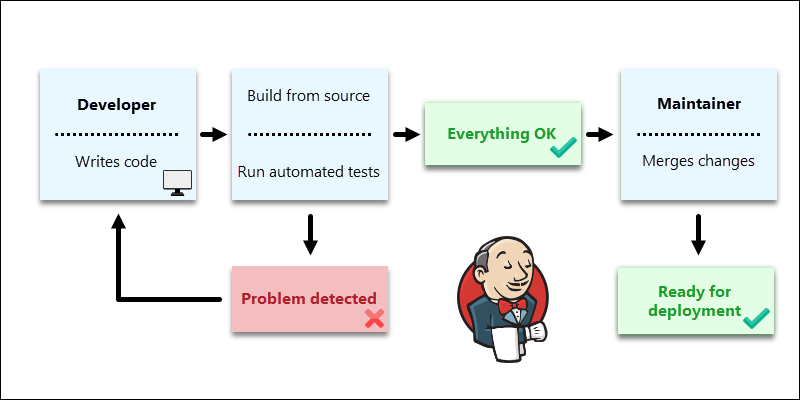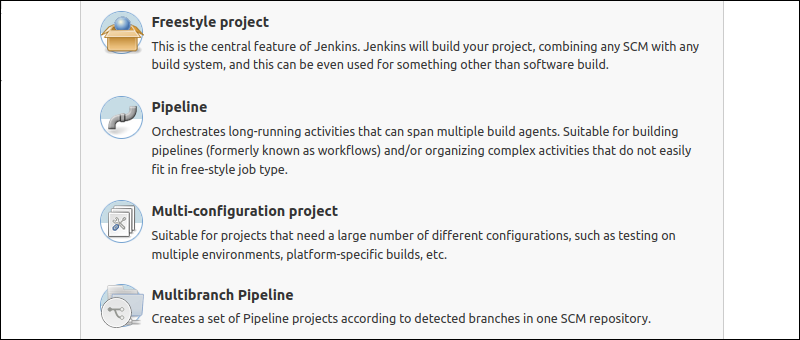Introduction
Jenkins is a platform for creating a Continuous Integration/Continuous Delivery (CI/CD) environment. The system offers many different tools, languages, and automation tasks to aid in pipeline creation when developing and deploying programs.
Although Jenkins requires scripting some automation steps, the program provides a fast and robust way to systematize the software development lifecycle.
Continue reading to learn more about Jenkins and why it's one of the leading DevOps tools today.

Jenkins Definition
Jenkins is an automation server written in Java that helps build, test, and continually deploy software. The open-source system is currently one of the leading automation servers.
In general, Jenkins provides support for:
- Various version control tools such as Git.
- Building Ant and Apache Maven-based projects.
- Running Bash scripts and Windows batch files.
A Short History of Jenkins
The Jenkins project started in 2004 under the name Hudson. The developer Kohsuke Kawaguchi, who worked at Sun systems, wanted to create a method to perform continuous integration. The idea was to test the code before committing to avoid breaking builds.
The idea proved successful and quickly spread to the rest of his team. As a result, Kohsuke Kawaguch created the Jenkins project and open-sourced the program. The usage spread across the world with a current estimate of 1.6 million users.
What Is Jenkins Used For?
Although Jenkins started as a continuous integration tool, the current use covers the whole software delivery pipeline, including deployment.
Note: The CI/CD pipeline is an intensive workload which requires high performance physical processors. phoenixNAP's Bare Metal Cloud deploys with cloudlike ease, while retaining the robustness of physical servers. Check out the BMC Compute instances for maximal processing potential.
The program runs web containers and plugins, such as Apache Tomcat, and helps manage lifecycle and access rights requests. Over 1700 plugins for Jenkins enrich the software integration, automation, and delivery processes and provide a customizable environment.
Jenkins Core Terminology
Jenkins encompasses various DevOps terminology throughout different pipeline creation and management options. Below is a list with some common terms and their definition.
Jenkins Pipeline
The Jenkins Pipeline is a user-made model for the continuous delivery pipeline. The Pipeline incorporates various plugins that help define procedure steps from version control to the users.
All software changes and commits go through a complex process before the release. The method includes three steps:
- Automated building.
- Multi-step testing.
- Deploying procedures.
In Jenkins, there are two ways to create a pipeline:
- Define the Pipeline through the user interface directly.
- Use the Pipeline as Code methodology and create a Jenkinsfile. The text file uses Groovy-compatible syntax to define the pipeline process.
The Jenkinsfile syntax is either declarative or scripted.
A basic declarative Jenkinsfile pipeline is simpler to understand. An example looks like the following:
pipeline {
agent any
stages {
stage('Build') {
steps {
echo 'Building…'
}
}
stage('Test') {
steps {
echo 'Testing…'
}
}
stage('Deploy') {
steps {
echo 'Deploying...'
}
}
}
}The code has the following elements:
- The mandatory
pipeline { }block invokes the Jenkins Pipeline plugin. - The keyword
agentdefines where the Pipeline runs, whereanyindicates the Pipeline runs on any available agent. - The
stages { }block represents the sequence in which the Pipeline runs. - The code contains three stages:
Build,TestandDeploy, each with its respectivesteps { }. - The
steps { }tell Jenkins what to do at a particular point.
The scripted equivalent of the Jenkinsfile looks like the following:
node {
stage('Build') {
echo 'Building…'
}
stage('Test') {
echo 'Testing…'
}
stage('Deploy') {
echo 'Deploying…'
}
}Checking a Jenkinsfile into a source control tool allows the whole team to edit, review, and adapt the steps in the delivery pipeline.
Continuous Integration
Continuous integration is a software development procedure where each applied change invokes an automated build test. The process ensures the code integrates into a working executable form without bugs.

Continuous integration is an essential aspect in environments with multiple developers. Each developer makes changes to code, and each change has potential issues.
A continuous integration tool such as Jenkins helps test, identify, and address problems before applying changes to production.
Automated Testing
Automated testing for Jenkins presets test execution and stores the results. The idea is to ensure code works in various scenarios. Creating automated tests for distinct environments, such as several Java versions or operating systems, helps foresee and prevent problems in later releases.
The automated testing phases embed into the CI pipeline in Jenkins seamlessly. Various plugins help run unit, integration, functional, and regression tests and store the results for later viewing and analysis.
Controller (Formerly Master)
The Jenkins architecture caters to distributed builds. One node is the central control unit and organizer, known as the controller.
The controller is the central process where the Jenkins configurations reside. Formerly known as the Master, the Jenkins controller manages agents and their connections, helps load plugins, and coordinates the project flow.
Agent (Formerly Slave)
The agents connect to the Jenkins controller to run projects. Agents require a Java installation on a physical or virtual machine, such as Bare Metal Cloud instances, Docker images, or Kubernetes clusters.
Agents in Jenkins help provide better performance by load balancing builds and creating a secure environment, separate from the controller.
Node
A node is a general term for agents and controllers, regardless of their actual role. Any machine with the ability to build projects and pipelines is a Jenkins node, and the controller is known as the built-in node.
The built-in node monitors the health of all attached nodes and takes them offline if any values go above a threshold.
Project (Formerly Job)
A Jenkins project, or a job, is a user-made automation procedure with a particular goal. Jenkins offers various build jobs by default, and more are available through plugins.

Below is a table with a short description of some project types.
| Project | Description |
|---|---|
| Freestyle | An unrestricted build task with multiple operations. |
| Pipeline | A multi-step project with several build agents. |
| Multi-configuration | A project with multiple test environments and different configurations. |
| Multi-branch Pipeline | A project which creates a set of pipeline projects according to branches in a source control management system. |
Build
In Jenkins, builds represent single execution of a job with the current configuration. A build creates software from different sources defined in the project procedure. Depending on the project, the build mechanisms include:
- Gathering dependencies.
- Compiling or transforming code.
- Archiving materials.
- Testing.
- Deploying to different environments.
Therefore, a build is one run of a defined project with various steps.
Note: Learn how to make software development and deployment more efficient by using Jenkins Shared Libraries.
How Does Jenkins Work?
Jenkins takes the development steps from integration to deployment, automating every step of the way.
Each time a developer publishes a commit to the source code repository, Jenkins triggers a build. Typically, the commits post to a development branch.
The build steps include testing the code, ensuring the build does not break. If any error occurs, Jenkins notifies the developer to act accordingly. If all tests pass, the Pipeline proceeds to the integration steps.
Integration takes longer and requires testing the code against multiple system configurations. Jenkins performs parallel integration tests on different nodes, reducing the time needed to try and integrate code.
Further down the Pipeline, Jenkins automates user acceptance testing, which is a requirement before deployment. If all tests pass, the code merges into the main branch, making the code available to the users.
Jenkins Features
The main features of Jenkins are:
- Easy installation. The java-based program is autonomous and platform agnostic.
- Straightforward to configure. The user-friendly web interface makes configuration an easy process. For first-time setup, refer to our Jenkins tutorial.
- Customizable with massive plugin availability. Currently, there are over 1700 available plugins to extend Jenkins' functionality. For any missing features, import additional external or custom-made plugins.
- Open-source. Jenkins is completely open-source and free to use, making it a cheap technology to implement.
Note: Refer to our article Jenkins vs. Kubernetes to learn the key differences.
Benefits and Drawbacks of Jenkins
Jenkins comes with certain advantages and disadvantages. Below is a detailed overview of both the pros and cons of working with Jenkins.
Benefits of Jenkins
Some benefits that come with Jenkins are:
- Faster development cycle. Builds and tests on every commit create a fast-paced environment for getting rid of bugs. New features and releases reach the end-user faster and with fewer errors.
- Less time to integrate code. Before Jenkins, code integration was a manual process, and debugging code was complex. Reaching a working version would require going through various commits and analyzing problems. When using Jenkins, integrating after each commit assures that the program functionality is always available and operational.
- Quick feedback for developers. Whenever a build breaks, developers stay informed. The feedback system helps the dev team quickly address the issues instead of debugging numerous commits.
- Automated pipeline workflow. Automated testing for each commit integrates into the Pipeline directly.
Disadvantages of Jenkins
Below are some disadvantages when working with Jenkins:
- Costly. Although Jenkins is free, the program requires a stable and robust infrastructure.
- Constant maintenance. Maintaining a Jenkins server is time-consuming. Adding stages to a pipeline, upgrading the server with new features, and tracking plugin updates require an administrator to restart and manage the server manually.
- Developer-centric. The platform is feature-driven and not very user-friendly for non-developers. Some developer experience is a must-have when working with Jenkins.
How to Install Jenkins
Jenkins works on various operating systems and environments. The installation is available in many forms, such as:
- Installer packages for major operating systems, such as Windows, Ubuntu, Debian, CentOS, etc.
- A WAR archive file.
- A Docker image.
- On a Kubernetes cluster.
- Source code build.
Jenkins runs as a stand-alone package or on a Java application server. The user interface is web-based and comes with a REST API in both cases.
Note: Check out our step-by-step guide If you would like to learn how to configure Docker in Jenkins.
Conclusion
Currently, Jenkins is one of the best CI/CD tools and is essential for DevOps and agile teams. For more DevOps topics, check out our list of the best DevOps tools.